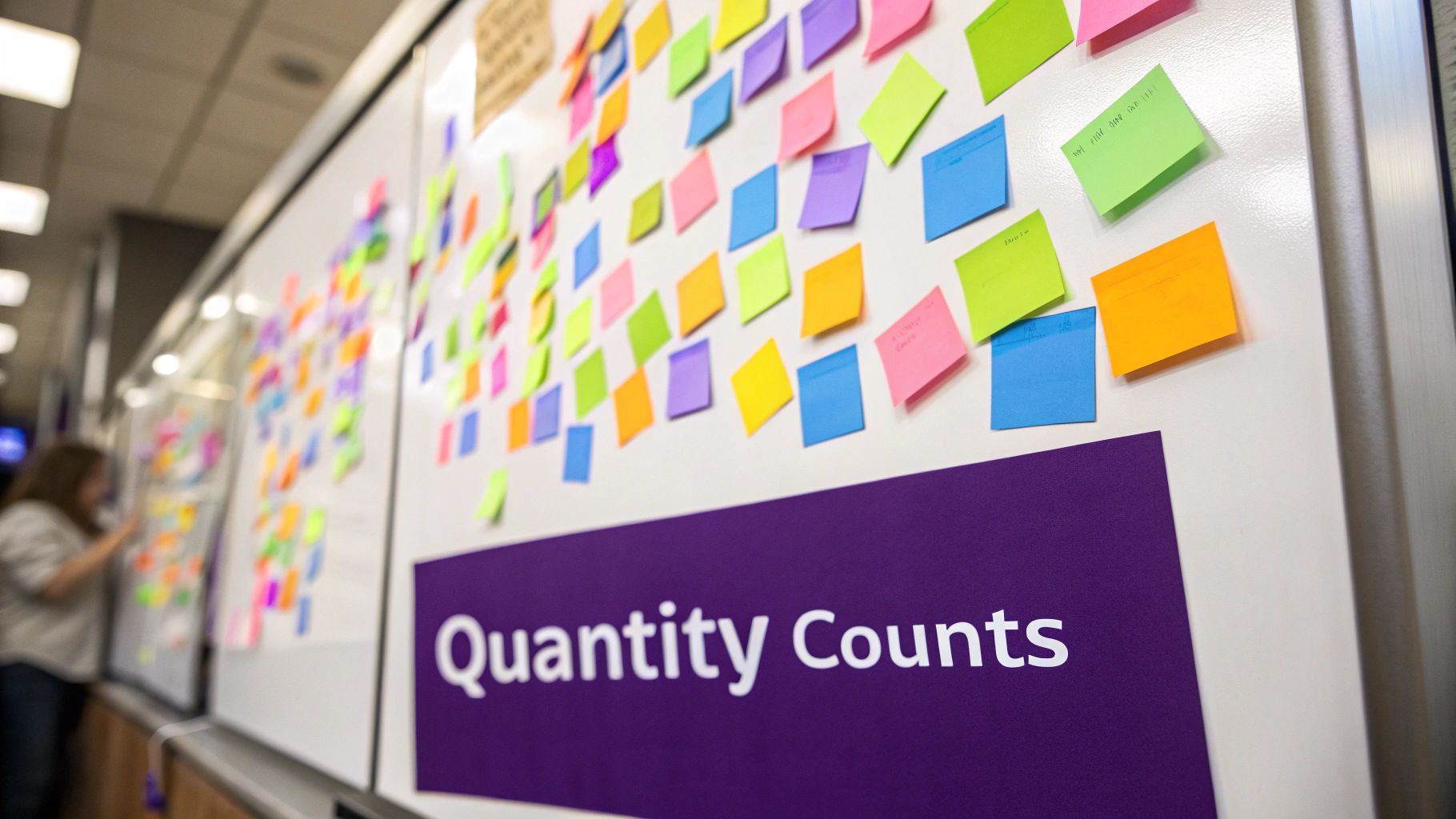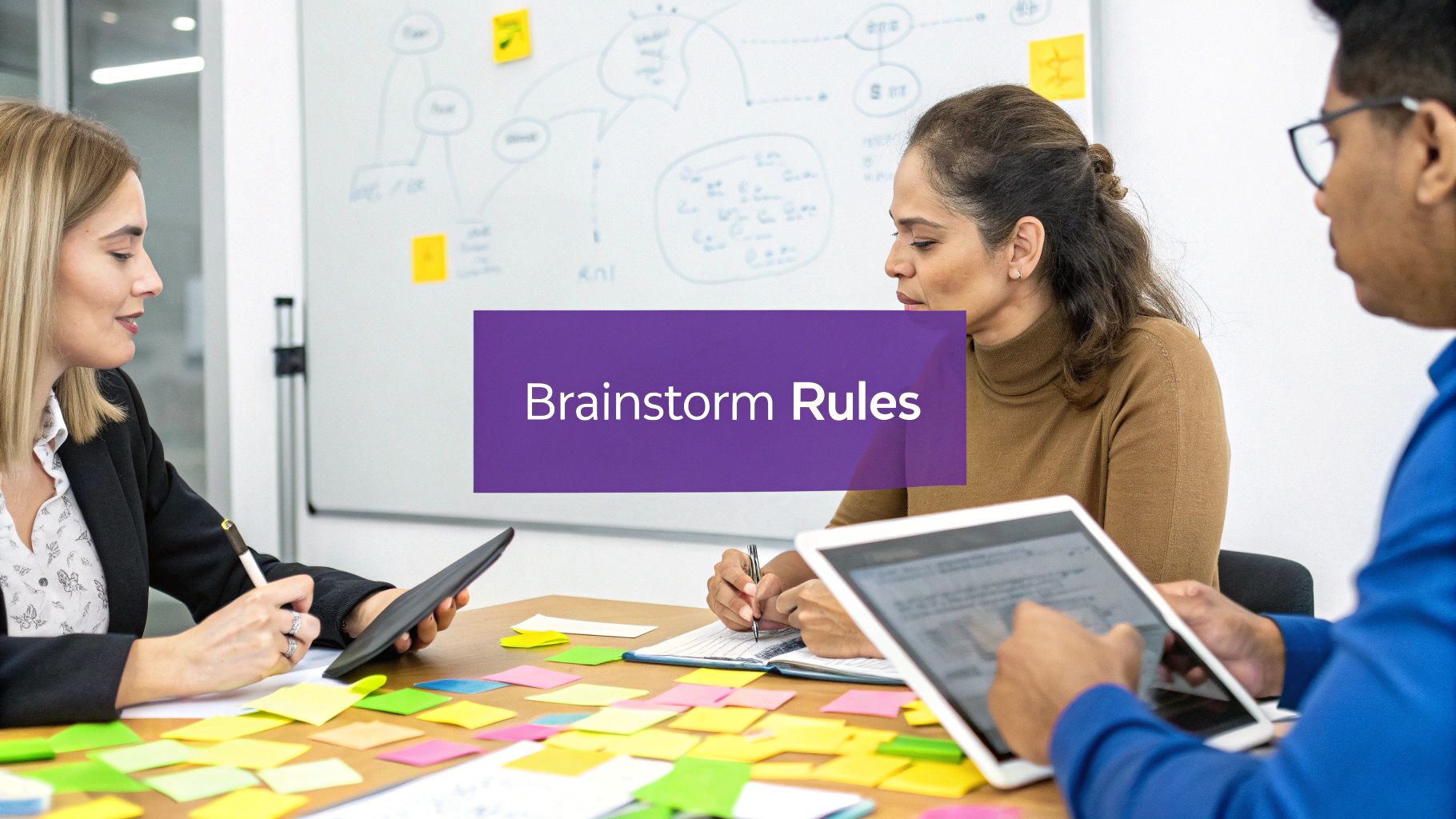In today's fast-paced, remote-first world, a stagnant brainstorming session is more than just a waste of time—it's a missed opportunity. The old methods of gathering in a room and shouting ideas often fail to capture a team's true creative potential, especially when collaborating across different locations. Cognitive biases, fear of judgment, and unstructured chaos can derail even the most well-intentioned efforts, leading to frustration and lackluster results.
This is where a clear framework becomes critical. Understanding and implementing a set of proven rules for brainstorming transforms these sessions from unproductive meetings into powerful engines of innovation. Following these principles helps foster a psychologically safe environment where creativity can flourish, which is a cornerstone for building better team dynamics. When teams feel secure enough to share bold ideas, it not only improves the brainstorming output but also strengthens the foundation for effective cross-department collaboration strategies that drive wider organizational success.
This guide breaks down the 7 fundamental principles that will help your team, whether in-person or virtual, generate groundbreaking ideas consistently. We'll explore actionable strategies to overcome common hurdles and ensure every voice is not just heard, but amplified.
1. Defer Judgment – No Criticism During Idea Generation
Of all the rules for brainstorming, this is the non-negotiable foundation. Deferring judgment means you must temporarily suspend all criticism and evaluation during the idea generation phase. The goal is to separate the creative act of producing ideas from the analytical act of assessing them. Mixing these two thought processes at the same time is a surefire way to stifle innovation and shut down participation.
By creating a psychologically safe, judgment-free zone, you empower your team to share raw, unconventional, or half-formed ideas without fear of immediate pushback. This is how you uncover truly breakthrough concepts. World-renowned innovation firms like IDEO and the Stanford d.school have this principle at the core of their creative methodologies, understanding that the wildest ideas often contain the seeds of brilliance.

Why It's a Critical Brainstorming Rule
Our brains are naturally wired to analyze and find flaws. This is a valuable skill for problem-solving, but it’s a creativity killer during ideation. When a team member shares a new idea and is met with "that will never work because…" or "we tried that before," it sends a clear signal: only safe, pre-vetted ideas are welcome. This leads to incremental thinking, not innovation. Deferring judgment encourages quantity over quality initially, which is a key to successful brainstorming.
How to Implement a No-Criticism Rule
Putting this rule into practice requires active facilitation and clear guidelines for everyone involved, especially in a remote setting.
- Establish Ground Rules: Before the session begins, explicitly state that there will be no criticism, debate, or evaluation of ideas. Explain that a separate time will be designated for this later.
- Use Additive Language: Encourage participants to build on each other's contributions. Instead of "Yes, but…," train the team to use phrases like "Yes, and…" to expand on an idea rather than shut it down.
- Post Visual Reminders: In a physical or virtual space (like a Miro or Mural board), have a visible reminder that says "Defer Judgment" or "Quantity Over Quality."
- Gently Intervene: As a facilitator, if you hear criticism creeping in, gently redirect the conversation. A simple, "Great point, let's capture that for our evaluation phase later. For now, let's focus on generating more ideas," works perfectly.
For remote teams looking to enhance psychological safety, anonymous idea submission can be a powerful technique to support the no-judgment rule. You can discover more about this method and explore different strategies for boosting creativity with anonymous brainstorming sessions.
2. Go for Quantity – Generate as Many Ideas as Possible
This rule shifts the focus from finding the perfect idea to generating the most ideas. The core principle is that quantity ultimately breeds quality. By aiming for a large volume of concepts, you increase the statistical probability of uncovering a few truly brilliant, innovative solutions. This approach prevents teams from prematurely fixating on and over-analyzing the first few suggestions, keeping the creative momentum high.
This mindset encourages broad exploration and lowers the pressure to contribute something groundbreaking with every turn. Pioneered by brainstorming originator Alex Osborn and embraced by modern methodologies like Design Thinking, this rule recognizes that the initial goal isn't perfection, but a rich pool of raw material to refine later. Companies like Toyota, known for their continuous improvement culture, thrive on this by processing thousands of employee ideas annually.

Why It's a Critical Brainstorming Rule
Focusing on quality too early engages the analytical part of our brain, which is the natural enemy of free-flowing creativity. It causes hesitation and self-censorship, as participants worry their idea isn't good enough. Aiming for quantity short-circuits this analytical instinct. It turns the session into a fast-paced, energetic game of producing as much as possible, which often leads to more creative and unexpected connections between thoughts. This is one of the most effective rules for brainstorming because it builds a foundation of possibilities from which to choose.
How to Implement a Quantity-First Rule
Driving up the idea count requires specific techniques and a high-energy environment, especially when facilitating for a distributed team.
- Set Specific Quantity Targets: Start the session with a clear, ambitious goal. For example, "Let's generate 75 ideas in the next 25 minutes." This gamifies the process and gives the team a concrete target to rally behind.
- Use Rapid-Fire Techniques: Employ methods like brain-writing or round-robin brainstorming where everyone contributes ideas simultaneously or in quick succession. This minimizes downtime and keeps the pace brisk.
- Keep Ideas Brief: Instruct participants to capture ideas as short headlines or single sentences on virtual sticky notes. There's no need for detailed explanations at this stage; the goal is to get the concept down quickly and move on.
- Celebrate Milestones: Acknowledge progress as you hit certain numbers, like 25, 50, or 100 ideas. A quick "Great, we just passed 50 ideas! Let's keep the momentum going!" can re-energize the group.
For teams looking to maximize their output, exploring a variety of structured methods is key. You can find several effective approaches by discovering more about different idea generation techniques for remote teams.
3. Build on Ideas – Use 'Yes, And…' Thinking
This rule transforms brainstorming from a series of individual contributions into a truly collaborative act of creation. Building on ideas means you treat every suggestion not as a final product, but as a starting point. This principle, famously borrowed from improvisational theater, uses the "Yes, and…" framework to encourage participants to accept an idea and then expand upon it, creating a positive, forward-moving momentum that fuels innovation.
This approach prevents ideas from being judged or discarded prematurely, instead treating them as building blocks. Innovation hubs like the Stanford d.school and renowned creative groups like Second City have long championed this method. They understand that a good idea rarely emerges fully formed; it evolves through collective enhancement, combination, and modification, turning simple concepts into sophisticated solutions.

Why It's a Critical Brainstorming Rule
Isolated ideas have limited potential. True breakthroughs often occur at the intersection of different concepts. The "Yes, and…" mindset creates an environment where participants are actively listening and looking for ways to connect, combine, or enhance what others have shared. Instead of a competitive dynamic where everyone is trying to pitch their own best idea, it fosters a cooperative one where the group works together to build the best possible outcomes. This collaborative energy is one of the most powerful rules for brainstorming, as it multiplies the creative output of the entire team.
How to Implement 'Yes, And…' Thinking
Facilitating this rule requires more than just saying the words; it's about embedding a collaborative and additive mindset into the session's flow.
- Model the Behavior: As the facilitator, start by actively building on the first few ideas shared. Say, "Yes, and we could take that concept and apply it to our mobile users," to show the team how it's done.
- Encourage Piggybacking: Use prompts like "How can we build on that?" or "What does that idea make you think of?" to invite others to add their perspective to an existing thought.
- Visualize the Connections: On a physical or digital whiteboard, use lines or arrows to connect ideas that build on each other. Creating visual clusters helps the team see how concepts are evolving and interlocking.
- Document Idea Chains: Note how a simple initial thought transforms through several "Yes, and…" additions. This not only values every contribution but also helps trace the origin of the final, more complex idea.
For remote teams, establishing a culture where everyone feels empowered is essential for this rule to succeed. You can find more strategies for encouraging open participation in our guide to improving the sharing of ideas in virtual meetings.
4. Welcome Wild Ideas – Encourage Unconventional Thinking
This rule is a direct invitation to break free from the constraints of practicality and realism. Welcoming wild ideas means actively encouraging participants to share their most unconventional, over-the-top, or seemingly impossible concepts. The purpose isn't necessarily to implement these "crazy" ideas as is, but to use them as catalysts to stretch the team's creative boundaries and uncover innovative pathways that incremental thinking would never reach.
This principle is at the heart of many disruptive innovations. The initial concepts for Tesla's electric vehicles were seen as wildly impractical in a gas-dominated auto industry, and Amazon's drone delivery system started as a futuristic, almost unbelievable idea. These examples show that today's wild idea can become tomorrow's industry standard. This is one of the most powerful rules for brainstorming because it gives teams permission to think big.

Why It's a Critical Brainstorming Rule
Conventional thinking leads to conventional results. To achieve breakthrough innovation, you have to explore the edges of what’s possible. Wild ideas act as stepping stones; even if a wild idea itself is not viable, it can spark a more practical, yet still innovative, idea in someone else. They challenge underlying assumptions about budgets, technology, and market realities, forcing the group to reconsider the problem from a completely new angle. This approach is essential for escaping the gravity of "how we've always done things."
How to Implement a Wild Ideas Rule
Encouraging unconventional thinking requires more than just saying it's okay; it requires creating an environment where it's celebrated.
- Set the Stage: Begin the session by explicitly asking for the "wildest," "craziest," or most "impossible" solutions. Frame it as a fun challenge to see who can come up with the most out-there concept.
- Use Creative Prompts: Use prompts that remove constraints. Ask questions like, "What would we do if we had an unlimited budget?" or "How would we solve this in a science fiction movie?"
- Celebrate the Outlandish: When a truly wild idea is shared, praise the contributor for their creativity. You could even create a special section on your virtual whiteboard labeled "Wild Ideas Parking Lot" to give them special recognition.
- Build from the Fringe: As a facilitator, take a wild idea and ask the group, "What's a more toned-down version of this?" or "What element of this crazy idea could we actually use?"
This technique is particularly effective for remote teams trying to solve complex problems. You can explore a full guide on how to encourage and manage these creative bursts with your team.
5. Stay Focused on Topic – Maintain Clear Session Objectives
While encouraging wild ideas and creative freedom, this rule ensures brainstorming sessions remain productive and don't devolve into unfocused conversations. Staying focused means every idea generated should, in some way, relate back to the core problem or objective defined at the start. It’s the essential guardrail that keeps creative energy channeled toward a specific, desired outcome.
This principle is about balancing divergent thinking (generating lots of ideas) with a convergent purpose (solving a particular problem). It prevents sessions from becoming tangential explorations that, while interesting, don't move the needle on the actual challenge. Methodologies like McKinsey's structured problem-solving and the challenge statements central to Design Thinking workshops are built on this very foundation: creativity needs a clear target to be effective.
Why It's a Critical Brainstorming Rule
Without a clear focus, a brainstorming session can easily lose momentum and purpose. Participants might start discussing unrelated work issues or exploring ideas that are interesting but irrelevant to the session's goal. This wastes valuable time and energy, leading to frustration and a lack of tangible results. A well-defined objective acts as a north star, allowing the team to explore creatively while ensuring that all paths eventually lead toward a viable solution for the stated problem. This focus is a cornerstone of the most effective rules for brainstorming.
How to Implement a Focus-First Rule
Keeping a creative session on track requires proactive facilitation and clear visual cues, especially when working with remote or hybrid teams.
- Make the Goal Visible: Write the central problem statement or question in large, bold letters on a physical whiteboard or at the top of a virtual collaboration space like Miro or Mural. This constant visual reminder helps everyone self-correct.
- Use a "Parking Lot": When a genuinely good but off-topic idea emerges, don't dismiss it. Acknowledge its value and place it in a designated "parking lot" area to be addressed later. This respects the contribution without derailing the current session.
- Conduct Regular Check-ins: As a facilitator, periodically ask, "How does this idea help us solve [the core problem]?" This gently nudges the conversation back on track and reinforces the session's objective.
- Timebox Exploration: Break the session into smaller, time-boxed segments. For example, allocate 15 minutes to explore one specific aspect of the problem before moving to the next. This structure helps maintain pace and focus.
For remote teams, having a dedicated facilitator whose primary role is to manage focus and time is crucial. You can learn more about how to structure these sessions for maximum impact by exploring resources on effective remote meeting facilitation.
6. One Conversation at a Time – Ensure Equal Participation
To unlock the collective intelligence of a group, every voice needs a chance to be heard. This rule establishes that only one person speaks at a time, preventing the chaos of multiple simultaneous conversations and ensuring all ideas are clearly presented and considered. It transforms brainstorming from a free-for-all into a structured, collaborative dialogue where even the quietest team members feel empowered to contribute.
This approach is fundamental to maintaining focus and respect within the session. When people talk over each other, ideas get lost, and frustration builds, shutting down creative momentum. By ensuring a single stream of conversation, you validate each contribution and create a more inclusive and productive environment. This structured participation is a hallmark of facilitated workshops at innovative companies like Airbnb and in formal academic research settings where clarity is paramount.
Why It's a Critical Brainstorming Rule
In any group setting, dominant personalities can unintentionally monopolize the conversation, while more introverted or reflective thinkers struggle to find an opening to speak. Enforcing a one-at-a-time rule levels the playing field, signaling that every perspective is equally valuable. This structured approach prevents the session from being hijacked by a few loud voices and ensures a richer, more diverse pool of ideas. Following this is one of the most effective rules for brainstorming to guarantee a fair and comprehensive outcome.
How to Implement a One-Conversation Rule
Managing the flow of conversation requires clear facilitation, especially in a fast-paced or remote environment.
- Use Round-Robin Techniques: Go around the virtual or physical room and ask each person to share one idea. This structured turn-taking guarantees that everyone gets a chance to speak without interruption.
- Implement a 'Talking Stick' or Signal: In person, a physical object (like a marker or a ball) can be passed to the designated speaker. Remotely, use a "raise hand" feature in video conferencing tools to create an orderly queue.
- Facilitate Active Listening: After an idea is shared, encourage a brief pause before the next person speaks. Ask the group to truly listen to understand, not just to respond. This slows down the pace and improves the quality of listening.
- Set Up Silent Brainstorming Periods: Begin with a "brainwriting" exercise where everyone writes down ideas silently on sticky notes or a digital whiteboard for 5-10 minutes. This allows for individual thought before the group discussion begins, ensuring ideas are formed without immediate influence from others.
7. Be Visual – Use Drawings, Diagrams, and Visual Aids
Words are powerful, but they aren't the only way to communicate an idea. One of the most effective rules for brainstorming is to encourage visual expression. This means using sketches, diagrams, flowcharts, or even simple stick figures to convey concepts. Going visual bypasses the limitations of language and engages different parts of the brain, often making complex ideas instantly more understandable and memorable.
This principle is a cornerstone of Design Thinking and is heavily practiced by innovation giants like IDEO and Google Ventures in their design sprints. They understand that a quick sketch can communicate a user interface or a customer journey far more effectively than a lengthy paragraph. Visuals create a shared language that transcends individual interpretations of words, leading to clearer communication and more aligned creative thinking.
Why It's a Critical Brainstorming Rule
Relying solely on verbal or written communication can slow down a session and lead to misunderstandings. A visual approach helps to clarify ambiguity, spark new connections, and make abstract concepts concrete. It also caters to different thinking styles, empowering visual learners who might struggle to articulate their thoughts in words alone. A simple drawing can become a focal point for discussion, allowing the team to build upon, question, and refine a concept together in real-time.
How to Implement a Visual-First Approach
Making your brainstorming sessions more visual is straightforward, especially with modern digital tools for remote and hybrid teams.
- Emphasize "No Artistic Skill Required": Make it clear from the start that the goal is communication, not creating a masterpiece. Simple shapes, lines, and stick figures are perfectly fine. This removes the fear of not being "a good artist."
- Provide the Right Tools: For in-person sessions, have whiteboards, large paper, sticky notes, and plenty of markers available. For remote teams, use a digital whiteboard tool like Miro or Mural that allows everyone to draw and collaborate simultaneously.
- Use Visual Prompts: Start the session with visual exercises. Ask participants to draw the problem or sketch a representation of the ideal customer experience.
- Combine and Label: Encourage participants to add short labels or keywords to their drawings to provide context. This combination of visual and text is often the most powerful way to capture an idea.
Using a structured visual framework can make this process even more effective. You can learn how to structure your visual ideas by exploring different types of a brainstorming graphic organizer to guide your team's creative process.
7 Key Brainstorming Rules Comparison
| Brainstorming Rule | Implementation Complexity 🔄 | Resource Requirements ⚡ | Expected Outcomes 📊 | Ideal Use Cases 💡 | Key Advantages ⭐ |
|---|---|---|---|---|---|
| Defer Judgment – No Criticism During Idea Generation | Medium – requires strong facilitation | Low – mainly behavioral enforcement | Safe environment fostering diverse, wild ideas | Early ideation phases needing psychological safety | Increased idea diversity; reduces self-censorship |
| Go for Quantity – Generate as Many Ideas as Possible | Low to Medium – focus on rapid pace | Moderate – time allocated for many ideas | Large pool of ideas increasing breakthrough chances | Sessions aiming for volume and momentum | High energy; prevents analysis paralysis |
| Build on Ideas – Use 'Yes, And…' Thinking | Medium – needs active collaboration | Moderate – ongoing engagement, note-taking | Refined, collective ideas with strong buy-in | Collaborative teams emphasizing idea evolution | Stronger concepts; builds team ownership |
| Welcome Wild Ideas – Encourage Unconventional Thinking | Medium – requires skilled facilitation | Low to Moderate – mindset and prompts | Breakthrough, unconventional ideas | Innovation focus requiring boundary-pushing thinking | Inspires breakthrough innovations; challenges norms |
| Stay Focused on Topic – Maintain Clear Session Objectives | Medium – demands strong moderation | Low – disciplined facilitation | Relevant, actionable ideas aligned with goals | Goal-oriented sessions needing efficiency | Time-efficient; maintains participant focus |
| One Conversation at a Time – Ensure Equal Participation | Medium – requires enforcement | Low – facilitation tools or cues | Balanced participation and inclusive dialogue | Verbal group brainstorms with diverse members | Prevents dominance; promotes active listening |
| Be Visual – Use Drawings, Diagrams, and Visual Aids | Medium – requires drawing materials | Moderate – space, materials, or digital tools | Clearer communication of complex ideas | Teams with visual learners or complex concepts | Enhances understanding; engages multiple learning styles |
From Ideas to Impact: Implementing Your Brainstorming Strategy
Moving from a chaotic free-for-all to a structured, high-output session doesn't happen by accident. It requires a deliberate shift in mindset and process. The seven foundational rules for brainstorming we've explored provide the essential framework for this transformation. They are not just suggestions; they are the core components of a repeatable system for creative problem-solving.
By mastering these principles, you are effectively building a psychologically safe and creatively fertile environment where every team member feels empowered to contribute. This structured freedom is the key to unlocking your team's full potential, especially in a remote or hybrid setting where clear guidelines are paramount for effective collaboration.
Key Takeaways for Lasting Change
Let's distill these rules into a simple, actionable mantra for your team:
- Create a Safe Space: The pillars of this are deferring judgment and ensuring one conversation at a time. When criticism is off the table and everyone's voice can be heard, participation flourishes.
- Fuel the Fire of Creativity: Encourage wild ideas and push for quantity over quality in the initial stages. This is how you break free from conventional thinking and uncover unexpected pathways.
- Build Momentum Together: The "Yes, and…" approach of building on others' ideas turns individual thoughts into a powerful, collective creation. Paired with visual aids, this makes abstract concepts tangible and collaborative.
- Maintain Purposeful Direction: None of this works without a clear goal. Staying focused on the topic ensures that your creative energy is channeled productively, leading to relevant and actionable outcomes.
Turning Ideas into Actionable Ventures
Consistently applying these rules for brainstorming will yield a wealth of validated concepts and innovative solutions. The next critical step is channeling that creative output into tangible projects. For many teams, especially in the tech world, this means turning a promising idea into a viable product or service. For those looking to apply brainstorming outcomes to real-world ventures, understanding the practical steps of how to start a tech startup can provide a roadmap from ideation to execution. A brilliant idea is only the first step; a solid implementation plan is what brings it to life.
Ultimately, mastering the art of brainstorming is about more than just generating ideas. It’s about building a culture of innovation, collaboration, and trust. It’s about creating a reliable engine for growth that can solve today's challenges and uncover tomorrow's opportunities. Start small, pick one or two rules to focus on in your next meeting, and build from there. The path from a blank whiteboard to a breakthrough solution begins with a single, well-structured conversation.
Ready to put these rules into practice without the guesswork? Bulby embeds these principles directly into guided, AI-powered brainstorming sessions for remote teams. Stop facilitating and start innovating by trying Bulby today.

